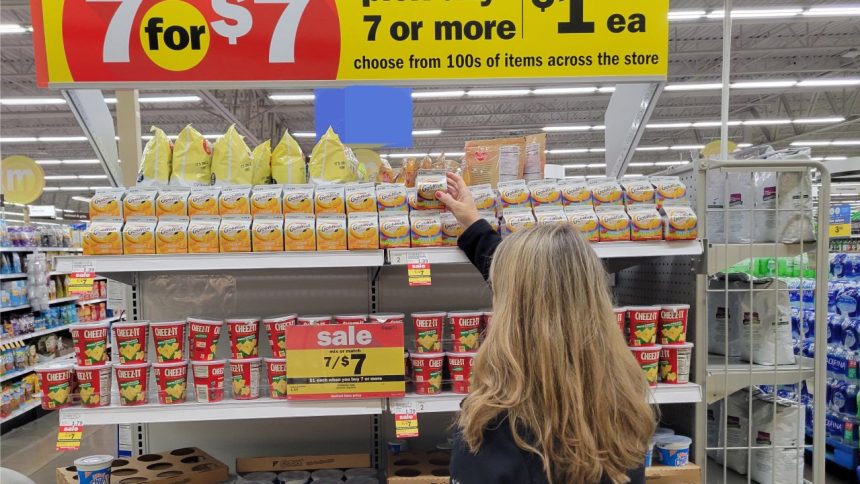Today was a good day to stock up on Goldfish crackers at my local grocery store. A large sign announced that buying seven or more snack-sized cartons allows you to get them at a discounted price of $1 each. Having several cracker enthusiasts in my household, I figured this sale might be worth my while.
Based on the terms of the sale, you’ll pay a slightly higher price, per carton, if you don’t buy at least seven of them. Of course, the sale applies to a broader assortment of items: You can actually mix and match from among many designated products in the store — as long as you’re buying at least seven.
These types of sales have been around for ages, although “spaving” is a modern term to describe them. The word is a combination of “spending” and “saving,” and the premise is you can save more by spending more.
What is spaving?
Spaving is the act of spending more money at stores to qualify for promotions such as a percentage-off discount, a free extra item or free shipping.
In addition to my seven-for-$7 Goldfish example, other types of deals that stores offer to encourage spaving include:
- Buying two items to get a third one half off
- Spending a minimum at an online retailer to get free shipping
- Spending a minimum online to get same-day shipping
Whether you’re shopping in person or online, spaving sales are very common. They can involve anything from small snacks or personal care items to big-ticket electronics or pieces of furniture.
When is spaving a good idea?
“When practiced wisely, spaving can be a beneficial strategy for saving money on purchases you’ll traditionally make, like buying in bulk for essential household items,” says Adam Davis, vice president of Financial Health and Liquidity at Capital One.
Spaving can certainly be worth your while if your original intention was to buy the number of items — or spend the minimum amount — required to get the deal. For instance, say you set out to buy four bedding sets, and realize the store is offering a buy-three-get-one-free sale. This could be your lucky day.
When is spaving not a good idea?
On the other hand, you could be out of luck, and out of hard-earned money, if you find yourself purchasing things you truly don’t need, just to get a deal.
My local store is currently running deals for $10 off a purchase of $40 or more on select nutritional or supplement products, as well as $7 off $30 or more on bulk coffee. I’d rather not get caught up in buying things I don’t want or need just to get a little money off.
The pitfalls of spaving
As tempting as a deal may seem, spending more money than you originally intended (or feel comfortable with) can result in:
- More credit card debt
- Less money in your bank account
- Increased clutter around your home
- Products that may expire before you use them
- Heightened levels of stress
“If you’re not careful, spaving can be problematic if it leads to impulse spending on items you don’t need, and interferes with your financial wellness and goals,” says Capital One’s Davis. “For the consumers that use this tactic for a majority of their shopping, it can lead to overspending, over-consumption, and credit card debt.”
3 ways to make wise purchasing decisions
Various rules of thumb can help you avoid making purchases you might ultimately regret:
1. Set a budget
A budget is a way to keep track of how much money you’re making and where you’re spending it. You can set up a budget using a handy budgeting app, a spreadsheet or a pen and paper. Paying attention to your finances through budgeting helps you be more mindful of how you’re spending your money.
“Creating and regularly tracking your progress against a budget is a good way to determine spending limits before shopping and prioritizing the items you need versus want,” Davis says. “Sticking to a budget will help you avoid overspending and stick to your overall financial goals.”
2. Avoid impulse purchases
As a rule, wait a set amount of time — at least 24 hours — before making purchases, especially big-ticket ones. This way, you can consider how badly you want or need the item. Likewise, when you’re aware of a sale, take sufficient time to compare it to other sales. It’s possible you could find a better deal elsewhere, maybe even one that won’t require you to spend more to get the discount.
3. Get into a money-saving mindset
The next time you’re tempted to make an impulse buy, ask yourself whether you’ll be happier if you put the money in your savings account instead. There’s a good chance you’ll go for the savings, after taking the time to think it over. Having more money in an emergency fund, for instance, can give you peace of mind, and better sleep at night, both of which just might be priceless.
Bottom line
If you find the right deal under the right circumstances, spaving can be worth your while. If you wind up buying items you don’t need, or spending more money than you’re comfortable with, it’s probably best to simply take a pass.
Also, enjoy the Goldfish when there’s a good deal — all seven boxes — unless you prefer the Cheez-Its.
Read the full article here
















